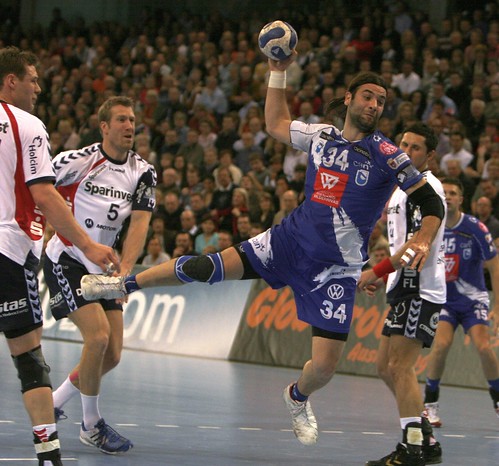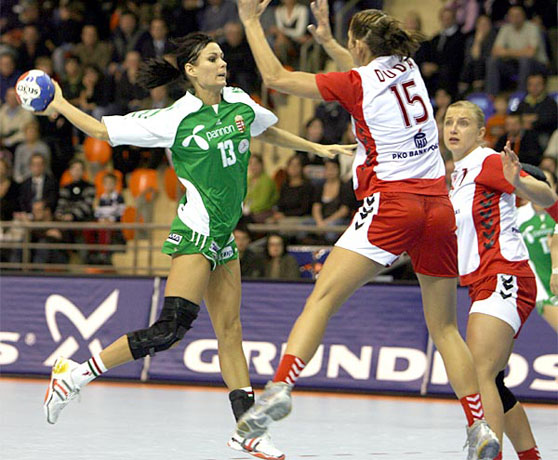Handball (also known as team handball, Olympic handball or European handball) is a team sport in which two teams of seven players each (six outfield players and a goalkeeper) pass and bounce a ball to throw it into the goal of the opposing team. The team with the most goals after two periods of 30 minutes wins. Handball is by far my favourite sport. I played handball for many years in Italy (a bit more seriously) and for a couple of years in Scotland (for fun) and was a coach for few years and despite the fact I am not coaching handball anymore, I still cannot believe how old fashioned handball training is.
Handball is a professional sport in many countries. In Germany, Spain, Denmark and Norway and many other European countries (mainly in Eastern Europe) there are full time coaches, players and support staff. The European Champion’s League is televised on Eurosport and in some games you can see more than 15000 supporters watching the game! In few words…it is a serious business!

(The Croatian Ivano Balic….possibly the best player in the World for Men’s Handball)

(The Hungarian Anita Görbicz….possibly the best player in the World for Women’s Handball)
If you have never seen a game of handball….you can get some ideas of how it is played on YOUTUBE.
Handball is a sport which is growing very fast in terms of spectators and media coverage, and is one of the top sports in Europe in terms of employment opportunities for coaches and sports scientists. Handball is an Olympic sport since 1972 in its indoor version. However, despite all the media interest, the sponsorships and the fact that Olympic medals are at stake, very little is available in terms of sports science. Very few research activities have been conducted and there is a paucity of published literature. A simple analysis on pubmed using the keyword “Handball” provides 343 entries (with many papers on injury rates and/or on a different sport also called Handball and played mostly in the USA and Canada). A keyword search for Basketball presents 1734 papers, and volleyball presents 693. In simple terms, there is clearly a paucity of information on Handball.
When we then analyse the scientific literature available, we then realise how little has been published on training and performance aspects as most of the literature refers to injuries in Handball.
A very recent review from Ziv and Lidor (Ziv, Gal and Lidor, Ronnie(2009) 'Physical characteristics, physiological attributes, and on-court performances of handball players: A review', European Journal of Sport Science, 9: 6, 375 — 386) has summarised all the available literature on handball and highlighted how little is known about this wonderful sport.
I have previously discussed on this blog specific aspects of physical preparation of handball players. However I would like to point out again that little is known about physiological demands and most of all about physiological characteristics of elite handball players. Ziv and Lidor summarised in Table 1 of their paper what has been so far published:
From the paucity of data on elite performers, you can clearly see that elite handball players are bigger and have more muscle mass than non elite. When I worked in Italy we used to benchmark our youth national teams and seniors with the World elite and it was always clear that in order to be World leading in this sport you needed height and fat free mass in particular in some playing positions.
Endurance capacity has always been a matter of discussion in the Handball coaching community. Despite the fact that Handball is clearly an intermittent sport (played on a 40m court!), a lot of attention was always devoted to endurance capacity. However data clearly show that handball players have a VO2max of 50-60 ml.kg.min-1, indicating that probably endurance capacity per se is not the most important performance-limiting factor. This has been supported by one scientific paper published by Gorostiaga et al. In fact, they conducted a study that examined endurance capacity in elite and amateur handball players while running at 10, 12, 14, and 16 km/h found no differences in mean blood lactate concentration or in mean heart rate (Gorostiaga et al., 2005). The mean running velocity and heart rate that elicited a blood lactate concentration of 3.0 mmol. l-1 were similar in both elite and amateur players, suggesting that endurance capacity per se does not differentiate elite from amateur handball players. In addition, no significant differences in endurance running at 10, 12, 14, and 16 km/h were observed in elite players over the course of a season (Gorostiaga et al., 2006). Despite this, a lot of handball coaches still put emphasis on training endurance capacity mostly in the form of long steady state running. However, it is important to state that we don’t have data on the top 5 national teams in the World and we have no idea if they are really different from the rest. Also, considering how fast the game is now played, we should clearly reconsider how to train handball players as I suspect metabolic demands are a lot higher than the ones recorder in the early 80s.
The most recent work on motion analysis characteristics is the one published by Luig et al. (2008) which conducted time-motion analyses during nine games of the 2007 men’s World Cup. The analyses were conducted using a computerized match analysis system. Four movement categories were defined in this study: walking, slow running, fast running, and sprinting. Playing time was significantly higher in wings (37.37 +/- 2.37 min) and goalkeepers (37.11 +/- 3.28 min) than backcourt players (29.16 +/- 1.70 min) and pivots (29.3 +/- 2.70 min). Total distance covered was higher in wings (3710.6 +/- 210.2 m) than in backcourt players (2839.9 +/- 150.6 m) and pivots (2786.9 +/-238.8 m). As anticipated, goalkeepers covered the shortest total distance (2058.1 +/-90.2 m). The total distance covered by field players consisted of 34.3 +/- 4.9% walking, 44.7 +/-5.1% slow running, 17.9 +/- 3.5% fast running, and 3.0 +/- 2.2% sprinting. Compared with other players, wings covered significantly shorter distances while slow running but significantly longer distances while fast running and sprinting. The distances covered are a lot less of what was reported in the 80s and is possibly due to how the game has changed with a better use of substitutions during the game to make sure players can perform fast movements for almost 21% of the total distance covered. To date, no study has been performed on oxygen consumption during handball games, but it is quite easy to predict what to expect considering the fast pace of handball playing. Quite simply, there is no information on handball performance which can help coaches identifying what the real demands are in particular at the very elite end of performance. I am sure data exist possibly in languages I cannot read and understand, I would be in fact very surprised if the elite handball nations don’t have such data to identify what they need in order to win an Olympic medal.
More data exist on strength and power capabilities and how training can influence throwing speed:
Again, few data here, but it seems feasible to suggest that strength training can improve throwing speed at least in non-elite players. The effectiveness of strength training on improving throwing speed in World class players is debatable mainly because there are no data to support or disprove this possibility. However, considering that Gorostiaga et al found a significant correlation between total strength training time and standing throwing velocities (r=0.58), and with my group we always improved throwing speed in national team players following a strength training programme, it seems feasible to suggest that strength training can improve throwing speed even in elite players. Throwing speed is of course only one part of the story, as accuracy is needed in order to score a goal as well as the ability to “beat” the goalkeeper. Incredibly there is virtually no information on interventions able to improve accuracy in handball players….
Handball is quite a demanding sport and being a “contact” sport eposes the players to a relatively high risk of injuries. Data from Beijing Olympics (Junge et al. 2009) clearly shows the high injury rates observed in Handball. 92% of the injuries occurred in competition. Of course during the Olympics teams tend to lower the intensity of training sessions and minimise physical contact in order to avoid injuries. However, it would be interesting to investigate injury rates in training and competition to find out if training sessions are too far from the competition demands as I suspect this is the case in many countries.
Who is going to invest in research activities on handball performance? Which country will be able to identify marginal gains to produce better players? Which country will be able to identify nutritional strategies to maximise performance in handball?
Maybe in few years we will have an answer, in the meantime, we can enjoy the competitions and hope that more research activities will be published on peer reviewed journals and websites for the good of coaches and players.

 orcid.org/0000-0002-2777-8707
orcid.org/0000-0002-2777-8707


















